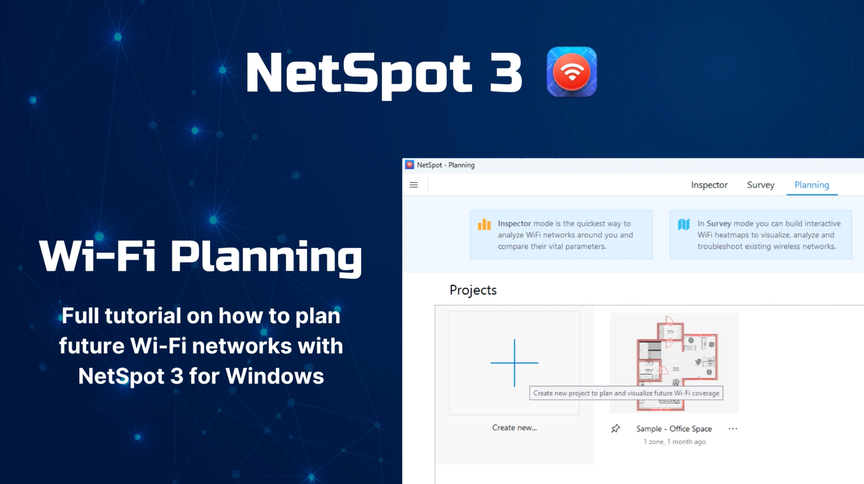Plan your Wi-Fi network with NetSpot Wi-Fi site survey tool
The seamless integration of wireless devices like laptops, smartphones, and tablets into our work environments is more important than ever, and a WiFi site survey can help you achieve this.
Small business owners realize how much more influence wireless local area networks (WLAN) have on every day of our lives now and how important it is to create the perfect working environment. With NetSpot planning tool it is quite easy to plan, configure, and deploy a wireless LAN.
WiFi Planning: Setting WiFi Coverage and Capacity Goals
To start the wireless planning right, you'll need to set the coverage and capacity goals, create a predictive model that calculates how many access points (APs) you'll need and what their ideal placement should be, verify the accuracy of the WiFi planning predictions with the help of a manual site survey, and be ready to adjust as you go.
A good WiFi network plan is supposed to answer these questions:
- How many APs is the network going to need?
- What is the most efficient placement?
- What configuration for the access points will work best?
- What coverage and performance am I aiming at?
With NetSpot WiFi planning tool — one of the best WiFi planning software tools — the aforementioned questions can be answered pretty precisely by creating a predictive design.
How to plan a WiFi deployment
When planning to deploy a wireless network, think of how many clients it is going to serve, how heavy the traffic will be, how many access points it is going to need and where exactly, how much throughput you want the network to provide. Consider the following factors for successful implementation of a wireless network for your business:
Know Your Building’s "Bones"
Before deploying a wireless network you should find out what your building is made of. Building materials like filled cinder blocks, brick, rock walls, or stucco construction are dense and can reduce the strength of your wireless signal, so you'll need a larger number of access points to ensure a fast, reliable connection. Anything that holds water, think pipes or bathrooms, can affect the range of a WiFi signal.
Balance the Load Accordingly
Smaller or medium-sized businesses usually need less than 24 access points, but bandwidth is to be considered too. The proper bandwidth helps with productivity, while the properly managed access points with according load balance are important as well. Use centrally-managed wireless controller appliances to boost network performance and save time.
When deciding on the type and number of APs to deploy consider the following:
- how many client devices will be sending and receiving traffic on each SSID at the same time;
- client devices possibilities;
- what apps the devices will use;
- users mobility on the network;
- the minimum throughput levels you want to have.
You can collect all this information by talking to site managers and to actual users of the network. The interviews can be personal or you can simply send the questionnaire to everyone.
- For new wireless deployments, you should ask people at each site to estimate the number of users — as well as the number of wireless devices — that will be active on the network at the same time. You'll need to know the types of devices and what users’ objectives are. Managers’ estimates about users and devices are usually quite accurate if they were working at this site previously.
- You may not need the exact number of visitors with wireless devices but an estimate is still worth having. Ask about their immediate requirements as well as what they think they will need in five years. Mostly you will get business objectives (shorter lines in stores) that you must turn into technical objectives (using mobile POS). Educating people about new technical solutions to fulfill business objectives plays big role in planning.
- Same questions are to be asked when replacing an old network with a new. An advantage in this case is that you can get statistics and observations on old setup. Measure activity and performance of the current network with NetSpot network monitoring tool that regularly polls, probes, and scans networks. Try to get access to remote collectors that collect data from agents running on network devices, as well as the inline appliances that monitor and analyze packets going through them.
- Now with all of the above information you can check LAN and WLAN traffic studies to pinpoint bandwidth targets for the various categories of users and traffic, as well as client devices. Also keep in mind that when an existing network needs to be replaced, most probably it had some shortcomings that needed to be eliminated — find those out and where in the building they tended to appear.
- Learn as much as you can about the wired network you are going to integrate the wireless devices with. Learn about topology and addressing scheme.
Perform a Predictive Site Survey
With all the information that you now have about network goals and user categories, it is time to use a planning tool to estimate the number of access points needed and the correct placement for them.
The WiFi planner will estimate the optimal number of access points and will map the effective placement of the points based on the size of the covered area, types of APs that you have, the type of coverage, etc. You'll be able to see the power levels of transmission and reuse patterns for the channel for both the 5GHz and 2.4GHz bands.
The map is very visual and helpful, you can simply drag the access points on the map to see what positioning gives you better coverage.
Power Up
Now that you know how many WLAN access points your network will need, decide on the power requirements to support these points, typically 15 watts or less. Depending on the size of a business, the requirements will differ. Consider power injectors option — they can be placed anywhere along the line within around 300 feet and will spare you the need for an external AC adapter.
WiFi Network Security and Safety
When a WiFi network lacks proper security measures, it becomes an open gateway for anyone to connect and potentially misuse. This is particularly concerning for business networks, where unauthorized access can lead to significant security risks. Implementing robust WiFi security protocols is essential for preventing such unauthorized connections.
Several different WiFi network security protocols are available, but they're not all equally effective. It's crucial to steer clear of outdated and insecure protocols like WEP (Wired Equivalent Privacy), which is now considered completely obsolete due to numerous security vulnerabilities.
WPA (Wi-Fi Protected Access) and WPA2 are far more secure than WEP, featuring a stronger encryption algorithm (AES 256 bit encryption). However, it's worth mentioning that these protocols are not entirely foolproof. Researchers have discovered significant vulnerabilities in WPA2, most notably through key reinstallation attacks (KRACKs).
Wi-Fi Protected Access 3 (WPA3) is the latest security standard for wireless networks. Developed by the Wi-Fi Alliance, WPA3 provides more robust protections against various types of attacks and unauthorized access, including KRACKs. With a more secure handshake protocol, individualized data encryption, and stronger password-based access, WPA3 is a significant upgrade in Wi-Fi security, and all users should enable it whenever possible.
How to perform a Predictive Site Survey with NetSpot
Since version 3.0, NetSpot is able to perform predictive site surveys, allowing you to accurately simulate your wireless network environment without physically setting up any hardware, significantly streamlining the WiFi planning process.
To start your predictive site survey using NetSpot version 3.0, simply follow these steps:
Launch the latest version of NetSpot and activate Planning mode.
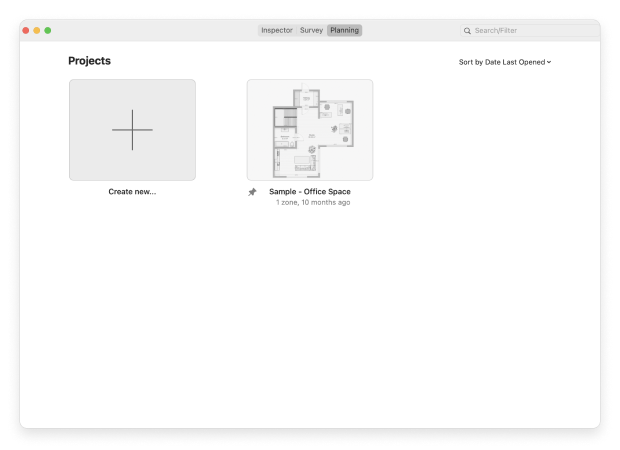
Create a new project and give it a descriptive name.
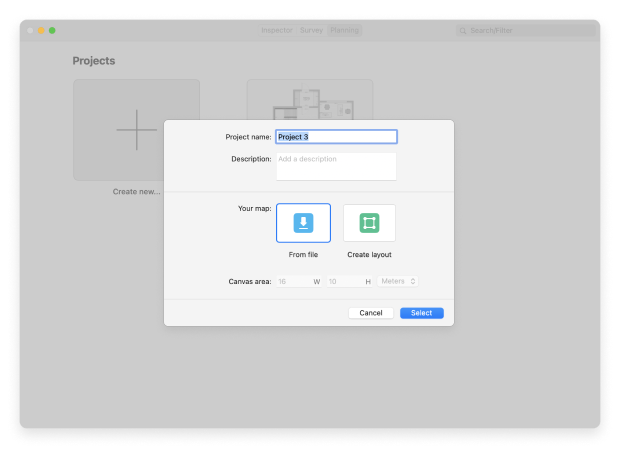
Load the map of your area from a file or create one using NetSpot’s built-in tools.
Calibrate the map by marking a known distance or area on the map layout, entering its real-life size or length.
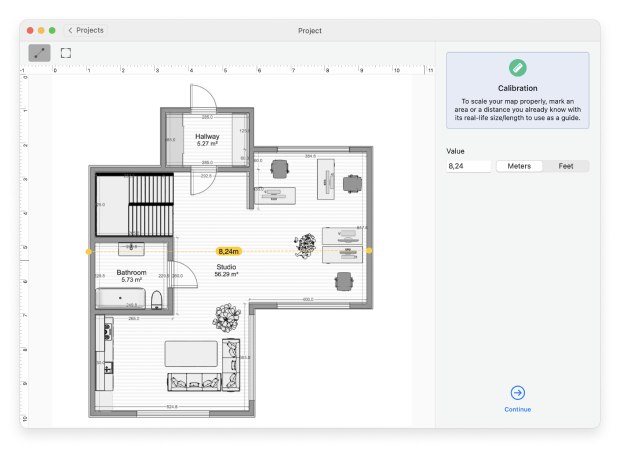
Add walls, windows, and doors, so that NetSpot has plenty of information to accurately simulate how different building materials will impact your WiFi signal. This is crucial for generating a reliable wireless network plan.
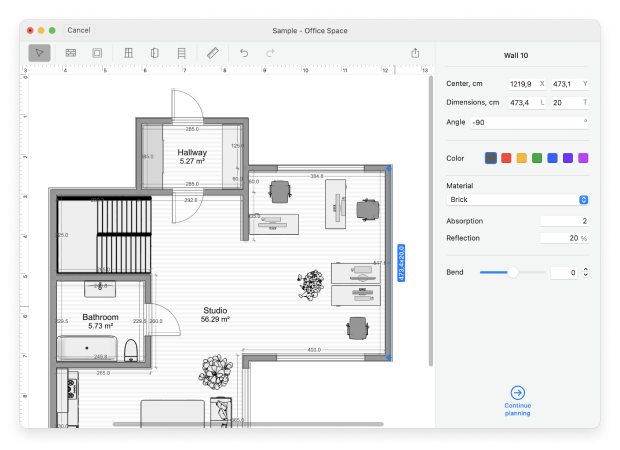
Add the virtual access points onto your calibrated map.
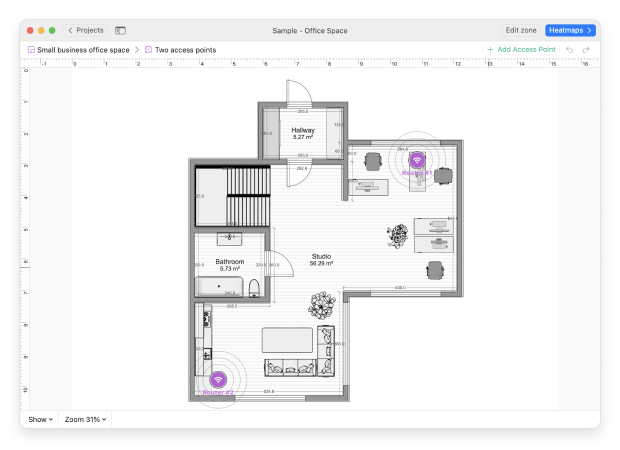
Click the Heatmaps button when you’re ready to start the simulation.
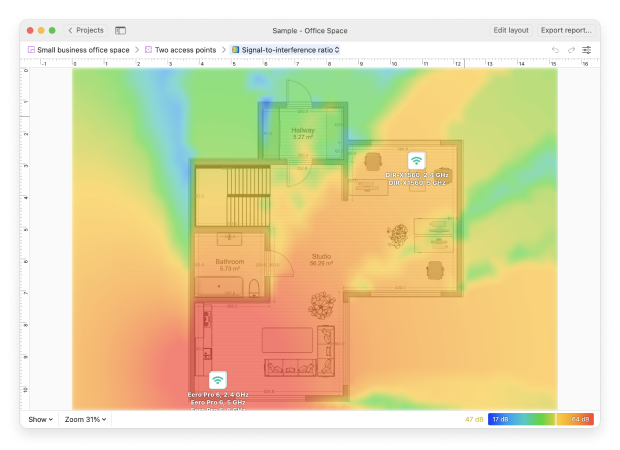
Analyze the generated heatmaps to decide if the virtual routers are placed correctly. If needed, adjust the positions of your virtual access points and rerun the simulation for improved results.
Perform a manual Site Survey
Use a Wi-Fi planning tool to do predictive site surveys, which will help with access points placement plus decide on which power levels to set according to the data collected at the interviewing stage.
Note that a predictive site survey won't count the neighboring WLANs co-channel interference, and the existence of electromagnetic signals from neighboring non-WiFi devices. To know more about these RF signals, a manual site survey is to be done. You might also want to look into performing an RF site survey for a more comprehensive analysis.
The manual real-time site survey will show you how accurate your predictive survey was within the architectural and RF environments. With all this data combined, you have all the information to design a better WiFi network that will meet and exceed expectations. If you're looking for specialized tools to facilitate this process, check out our list of the top WiFi site survey software currently available.
Keep the following tips in mind when performing a manual site survey:
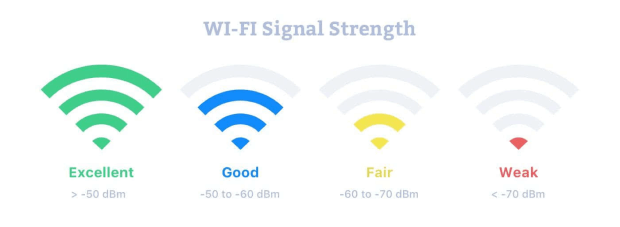
- It would be ideal if a client was able to detect a signal of -70 dBm or better from one access point and another signal of -75 dBm or better from one or more other points. A client will firstly connect to an access point with a stronger signal and as it moves closer to a different AP and the signal there grows stronger the client can switch to the new AP. In case there are too many access points with equally strong signals then you can consider thinning them out or lower their Tx power.
With all the data you collected and analyzed you have enough means for designing the wireless network.
Use the most suitable WiFi Planning tool
NetSpot 3 offers two approaches to WiFi planning: Single Hotspot Surveys and Predictive Surveys. These methods provide a comprehensive, data-driven foundation for your wireless network planning, ensuring optimal placement of single or multiple hotspots.
Strategically Plan Future Wireless Networks with a Single Hotspot
For those experienced in network planning, you might have a good sense of where to place your access points. However, when it comes to large, complex networks spanning multiple floors, precise calculations are essential.
Such surveys are created by starting a new project in NetSpot and defining the area you wish to survey. After placing your hotspot in the initially chosen location, take multiple samples to create your first snapshot of the zone. It's crucial to then physically move the hotspot to another location within the survey area for additional sampling. Create new snapshots at each relocated hotspot position, covering different areas of your intended network layout.
After you've surveyed the entire area in this manner, NetSpot enables you to merge these individual snapshots, resulting in a comprehensive, unified network survey as if you had multiple access points deployed from the start.
This all-encompassing survey takes into account key variables such as the presence of neighboring WLANs, the impact of adjacent and co-channel interference, as well as electromagnetic signals from non-WiFi devices that could adversely affect the Signal-to-Noise Ratio (SNR) for devices on your wireless network.
Perform a Predictive Survey to See the Future of Your Wireless Network
When planning a wireless network, predictive site surveys offer an invaluable method for simulating various deployment scenarios without the need to physically install hardware. Starting from version 3.0, NetSpot has integrated this cutting-edge feature, making WiFi planning an even more streamlined and efficient process.
In the predictive survey mode, NetSpot allows you to upload and calibrate a map of your intended coverage area. You can then add architectural details and virtual access points to the map. This pre-setup enables the software to generate precise simulations, including heatmaps, to guide your network design decisions. The ability to adjust virtual access points within these simulations offers a flexible, data-driven approach to planning, effectively removing much of the guesswork involved.
With these two powerful survey methods — Single Hotspot Surveys for real-world sampling and Predictive Surveys for virtual planning — NetSpot 3 provides a comprehensive suite of tools for anyone looking to create or optimize a wireless network.
Tip: If you're using a Mac for your WiFi planning, NetSpot offers WiFi site survey software specifically for Mac to ensure compatibility and ease of use. The same tool is also available as WiFi site survey software for Windows.
How To WiFi planning: tips & tricks
Some helpful tips to keep in mind when making a predictive WiFi design:
- Use one map image per floor, don’t lay out several floors on the same map. Assume one floor to be one zone. Breaking floors into multiple zones may not work very well.
- Be accurate, but keep it easy. There’s probably no need to draw every piece of furniture on the map. Simply drawing the main interior and exterior walls will do it.
- If you’re going to use location tracking (RTLS) indoors, place the APs in the corners and rooms instead of hallways. Don’t place APs in the same locations on neighboring floors, but rather in a zig-zag pattern.
- Use the heatmaps to evaluate the result. Does it meet the initial requirements or needs some tweaks? Not that it needs to be said, but use an optimal amount of APs — not too many not too few.
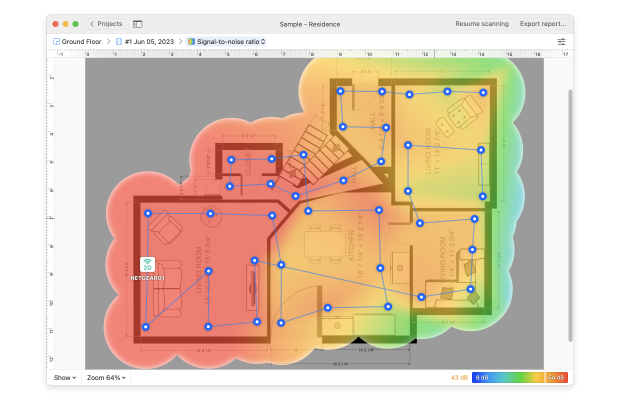
- In spaces with high ceilings, play with antenna downtilt / uptilt positioning.
- WiFi site survey software for Android offers the convenience of a lighter, more portable device without sacrificing in-depth network analysis capabilities. This enables quicker, more efficient on-site surveys and adjustments.
Once you are done with your off-site design, time to do the pre-deployment and post-deployment surveys on site with NetSpot WiFi planning tool to ensure the best result is achieved.
Common Wireless Networking Missteps
Ready to go online? Learn how to avoid some of the common wireless network perils:
This Access Point Worked at Home
Some wireless devices designed for home use may not be suitable for business environment, especially if the business is large. Home access points may cost cheaper but they were not made for a space bigger than a small home office and are usually meant for single deployments.
Add Access Points
The optimal locations for access points may not turn out to be the easiest ones. And while a wireless site survey is ideal, it may be costly for small businesses. The access point challenge can be solved with the help of one of the following approaches:
- Invest in multiple access points. In the long run you may find it cheaper than commissioning a site survey.
- Set up one AP and chart its coverage with one laptop. This rudimentary site survey of one access point coverage range will be your guideline for APs in the whole facility.
- Invest in a WLAN controller and NetSpot software. The controller accounts all connected access points and sets the proper channel and power allocation. NetSpot offers you a visual floor plan of the facility with the heat map explicitly showing the signal strength throughout.
Stay on Point
Once you set everything up it is easy to become unconcerned. However you should keep in mind that technologies evolve quickly as well as hackers' possibilities. Keep your small business safe and unexposed to security risks, keep up with what's going on with the wireless market and where the technology is headed. Staying ahead of any possible risks will save time and money.
Leave Room to Grow
When you build a WLAN, don't just think about current needs, try to think about the future of your network, and prepare to grow with the technology. An advantage of wireless structures is that they are relatively easy to rearrange. Try to think through the business goals and needs in the future — choose the equipment and configuration accordingly.
A wireless network is no doubt an important asset to any business, but as with everything else you should always consider the objectives, limitations, the potential benefits as well as possible problems. Being aware of both advantages and disadvantages will keep the efficiency on the higher level and will make your wireless network a valuable asset to a successful business plan.
Conclusion
Planning a wireless network is an important task that can greatly influence your overall online experience. While this task might seem difficult, utilizing specialized Wi-Fi planning software like NetSpot can simplify the process. With NetSpot, you can effectively map out your coverage area, estimate the optimal number of access points, and identify potential issues in your wireless network plan before they become actual problems.
WiFi Planning — FAQ
The term Wi-Fi planning refers to the process of designing and configuring a wireless network to meet specific coverage, capacity, and performance goals. Typically, Wi-Fi planning is aided by specialized tools like NetSpot, which simplify the complex task of wireless network planning.
Network planning can be broadly divided into the following sub-types:
- Predictive network planning: Involves using software tools to create a virtual model of the intended network environment.
- Post-deployment survey: Conducted after the network has been set up, this survey verifies if the network meets the initial design specifications and goals.
- Real-time network monitoring: The ongoing analysis of an active network to ensure its optimal operation.
To plan your Wi-Fi coverage, you can start by performing a predictive site survey to simulate how your wireless network will behave in a specific environment. This involves creating a virtual layout of the area where you intend to deploy the network, marking potential access point locations, and setting performance goals.
Estimate how many clients are going to connect to the deployed network, how much traffic is it going to need, and size up your space to see how many access points you might be installing.
To perform a WiFi site survey, use a WiFi planner tool like NetSpot. It can help you estimate the optimal amount of access points and will map out their efficient placement. The visual map is very helpful as you'll be able to drag the access points and see how their positions affect your wireless coverage.
A manual site survey benefits you in many ways: with the data collected you can easily create a better wireless network that will meet and exceed the expectations. When performing a manual site survey, keep the following in mind:
- For data services, the wireless devices on the network should have a minimum RSSI of -70 dBm and an SNR of at least 20 dB. For voice and video connection, aim for RSSI of at least -67dBm and SNR of at least 23 dB.
- You want a sufficient amount of access points in your network with strong signal. You don't need to overcrowd your space with APs however. An optimal AP placement will help you save money and build an even coverage.
- Using an access point not suitable for a specific environment. What works well for a private home network, might fail in a large business environment.
- Placing access points without any strategy. Perform a WiFi survey with NetSpot to determine optimal placement and number of devices.
- Not staying in the know. It is not just setting up the network that keeps it functioning well, it is also proper maintenance. Keep your business safe and unexposed to security risks, keep up with what's going on with the wireless market and where the technology is headed. Staying ahead of any possible risks will save time and money.
- Not thinking ahead. Don't just think about your immediate needs when setting up a network, try to think how it will develop and what your business might need from it in the future.
